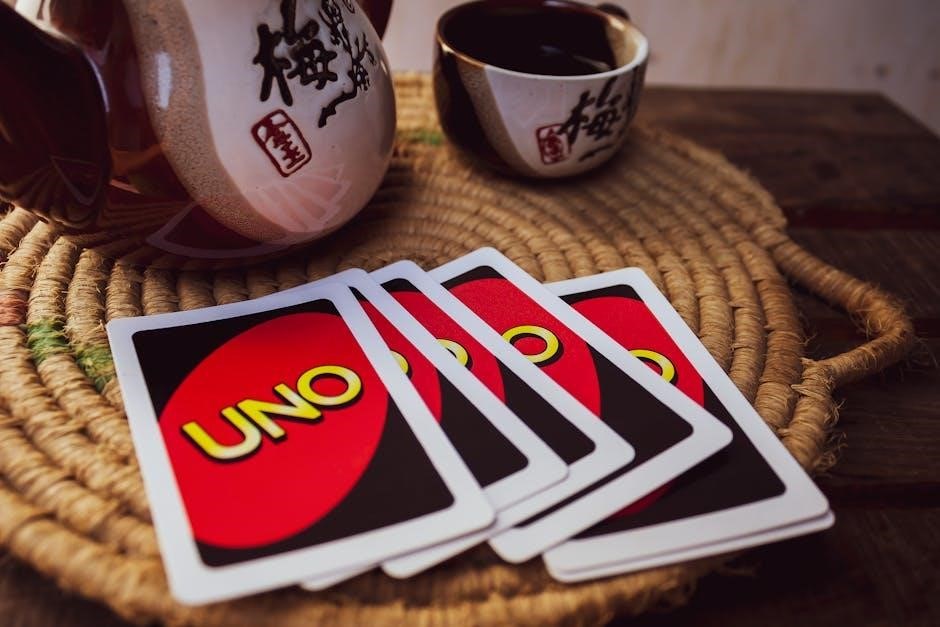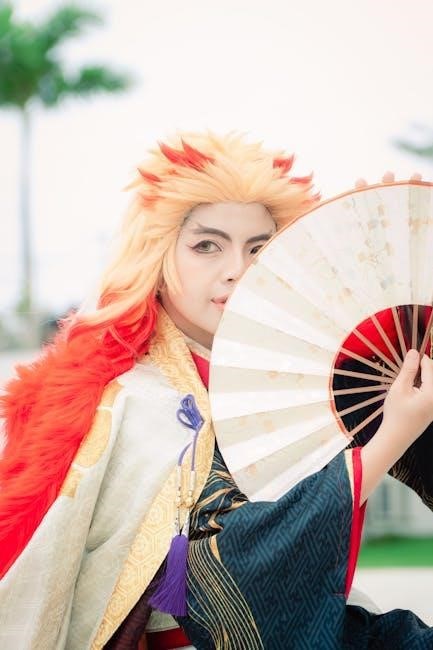Japanese Role-Playing Games (JRPGs) are a beloved genre known for rich storytelling, vibrant visuals, and immersive gameplay․ Originating in Japan, they blend cultural themes with universal appeal․
What Defines a JRPG?
Distinctive features include turn-based combat, deep character development, and narrative-driven storytelling․ JRPGs often emphasize emotional journeys, vibrant visuals, and unique cultural elements, setting them apart from Western RPGs with their focus on storytelling and player immersion․
Origins of JRPGs
JRPGs trace their roots to early Japanese computer games, influenced by Western RPGs like Ultima and Wizardry․ The 1980s saw pioneers like Dragon Quest and Final Fantasy, blending unique Japanese storytelling with RPG mechanics, establishing the genre’s foundation․
Key Characteristics
JRPGs are defined by rich storytelling, vibrant visuals, and deep character development․ They often feature turn-based combat, expansive worlds, and cultural themes․ Emotional narratives and strategic gameplay are hallmarks, creating immersive experiences that resonate deeply with players worldwide․
Evolution of JRPGs
JRPGs emerged in the 1980s, evolving from text-based adventures to iconic titles like Dragon Quest and Final Fantasy․ The 1990s saw a Golden Age with games like Chrono Trigger, blending innovative storytelling and gameplay․ Modern JRPGs now feature HD graphics, open-world designs, and global appeal, as seen in Final Fantasy XVI and Xenoblade Chronicles․
Early Years
JRPGs originated in the 1980s, evolving from text-based adventures․ Early titles like Dragon Quest and Final Fantasy pioneered the genre, blending storytelling, character progression, and turn-based combat, setting the foundation for future innovations․
Golden Age
The 1990s marked JRPGs’ golden age, with iconic titles like Chrono Trigger and Final Fantasy VI showcasing deep narratives, memorable characters, and innovative mechanics․ This era solidified JRPGs as a cornerstone of gaming culture, blending artistry and storytelling․
Modern Era
Modern JRPGs have evolved with stunning HD visuals, genre-blending mechanics, and diverse storytelling․ Titles like Persona 5 and Nier: Automata showcase innovation, while indies like I Am Setsuna honor classic traditions, ensuring JRPGs remain vibrant and influential․

Popular JRPG Subgenres
Traditional JRPGs focus on storytelling and turn-based combat, while Strategy RPGs emphasize tactical battles․ Action RPGs blend real-time combat, and Roguelike JRPGs feature permadeath and procedural generation, offering varied gameplay experiences․
Traditional, Strategy, Action, Roguelike
Traditional JRPGs offer deep narratives and turn-based systems, while Strategy RPGs focus on grid-based tactics; Action RPGs feature real-time combat, and Roguelike JRPGs introduce permadeath and procedural generation, enhancing replayability and complexity for diverse player preferences and challenges․
Japanese Role-Playing Games (JRPGs) are a unique genre characterized by intricate storytelling, vibrant visuals, and distinct gameplay mechanics․ Originating in Japan, they have captivated players worldwide with their cultural depth and creativity․
Definition
Japanese Role-Playing Games (JRPGs) are a distinct genre of video games characterized by deep storytelling, vibrant visuals, and strategic gameplay․ Originating in Japan, they emphasize character development, narrative depth, and often feature turn-based combat systems․
Origins
Japanese Role-Playing Games (JRPGs) emerged in the 1980s, influenced by early Western RPGs and Japanese culture․ Titles like Dragon Quest and Final Fantasy laid the foundation, blending storytelling, turn-based combat, and vibrant visuals into a unique genre․
Characteristics
JRPGs are known for engaging storytelling, vibrant visuals, and memorable characters․ They often feature turn-based combat, character customization, and exploration․ These games emphasize narrative depth and emotional connections, blending traditional and modern elements to create immersive experiences․

Evolution
JRPGs have evolved from early 8-bit and 16-bit games to modern 3D masterpieces, with advancements in storytelling, visuals, and gameplay mechanics while staying true to their roots․
JRPGs originated in 1980s Japan, influenced by early RPGs and Japanese culture․ Pioneers like Nintendo and Square introduced titles such as Dragon Quest and Final Fantasy, laying the groundwork for the genre with unique storytelling and turn-based mechanics․
The 1990s marked JRPGs’ golden era, with titles like Final Fantasy VII and Chrono Trigger showcasing deep narratives, memorable characters, and innovative graphics․ This period solidified JRPGs as a cornerstone of gaming culture, blending emotional storytelling with engaging turn-based mechanics․
Modern JRPGs blend traditional elements with contemporary innovations, featuring HD graphics, complex narratives, and hybrid gameplay․ Titles like Final Fantasy XV and Persona 5 showcase the genre’s evolution, appealing to both nostalgic fans and new audiences globally․
Gameplay Mechanics
JRPGs often feature turn-based or action-oriented combat, character progression, and strategic battle systems․ These mechanics, combined with narrative depth, create engaging experiences for players seeking both challenge and storytelling․
Turn-Based vs․ Action
JRPGs often feature turn-based combat, allowing strategic planning, while action-oriented systems emphasize real-time decisions․ Both styles cater to different player preferences, blending depth and pacing for unique experiences․
Japanese Role-Playing Games (JRPGs) are renowned for their intricate storytelling, vibrant visuals, and deep gameplay mechanics, offering unique cultural insights and shaping global gaming culture significantly․
Distinctive elements like turn-based combat, character development, and narrative depth define JRPGs․ They often feature vibrant visuals, memorable soundtracks, and deep storytelling, blending Japanese culture with universal themes that captivate global audiences and set them apart from other RPGs․
JRPGs trace their roots to early Japanese PC games in the 1980s, influenced by Western RPGs like Ultima and Dragon Quest․ These games laid the foundation for iconic franchises like Final Fantasy, shaping the genre into a cultural phenomenon․
- Deep storytelling with memorable characters and emotional depth․
- Turn-based or action-oriented combat systems․
- Extensive character development and customization․
- Vibrant, stylized visuals and impactful music․
- Cultural influences blending Japanese traditions with fantasy elements․
JRPGs evolved from early text-based adventures to rich, visually stunning experiences․ The 8-bit and 16-bit eras defined their identity, while the 1990s brought 3D graphics and cinematic storytelling, shaping the modern genre․
The early years of JRPGs began in the 1980s with titles like Dragon Quest and Final Fantasy, which laid the groundwork for the genre․ These games introduced turn-based combat and narrative-driven storytelling, setting the foundation for future innovations in the 8-bit and 16-bit eras․
The Golden Age
The 1990s marked JRPGs’ golden age, with titles like Final Fantasy VII and Chrono Trigger pioneering 3D graphics and deep narratives․ This era saw iconic storytelling, memorable characters, and gameplay innovations that set the standard for modern JRPGs․
Modern JRPGs
Modern JRPGs blend traditional elements with contemporary innovation, featuring HD graphics, cross-platform releases, and global connectivity․ Titles like Persona 5 and Nier: Automata highlight the genre’s evolution, combining deep storytelling with dynamic gameplay that resonates worldwide․
Traditional JRPGs emphasize storytelling and turn-based combat, while Strategy RPGs focus on tactical battles․ Action RPGs blend real-time combat with exploration, and Roguelike JRPGs introduce permadeath and procedural generation, offering diverse gameplay experiences․
Traditional JRPGs
Traditional JRPGs focus on storytelling and character development, often featuring turn-based combat systems․ These games typically include linear narratives, party-based exploration, and RPG elements like leveling up and skill customization, creating a classic and immersive gaming experience for players․
Strategy RPGs
Strategy RPGs combine role-playing elements with tactical gameplay, often featuring grid-based or open battlefields․ Players emphasize planning and strategic decisions over action, with examples like Fire Emblem showcasing deep character development and resource management, appealing to fans of tactical challenges and methodical gameplay․
Action RPGs and Rogue-likes
Action RPGs focus on real-time combat and fluid character movement, while Rogue-likes emphasize procedural generation and challenging gameplay․ Titles like Mystery Dungeon blend these elements, offering fast-paced action and unpredictable levels, appealing to fans of dynamic and replayable experiences․

Iconic JRPG Series
Iconic JRPG series such as Final Fantasy, Dragon Quest, and Tales have shaped the genre with their memorable characters, engaging stories, and innovative gameplay, leaving a lasting impact on gaming culture worldwide․
Final Fantasy Series
The Final Fantasy series is a cornerstone of JRPGs, renowned for its deep narratives, memorable characters, and evolving gameplay mechanics․ Each installment introduces unique worlds and themes, solidifying its legacy as a defining force in the genre․
Dragon Quest Series
The Dragon Quest series is a foundational JRPG franchise, celebrated for its traditional gameplay, iconic art by Akira Toriyama, and memorable scores․ It has deeply influenced the RPG genre and remains a cultural phenomenon in Japan, embodying timeless storytelling and innovation․
Tales Series and Others
The Tales series is renowned for its real-time battles and character-driven narratives․ Titles like Tales of Phantasia and Tales of Destiny emphasize deep storytelling․ Other notable JRPGs include Valkyria Chronicles and Nier: Automata, each offering unique twists and enriching the genre’s diversity․

Cultural Impact of JRPGs
JRPGs have profoundly influenced gaming culture, inspiring countless developers․ Their unique storytelling and artistry have transcended borders, fostering a global fanbase and shaping the evolution of interactive media․
Impact on Gaming Culture
JRPGs have significantly shaped gaming culture, inspiring Western developers and fostering innovation․ Their intricate storytelling, memorable characters, and rich cultural elements have set a benchmark, influencing countless titles and enriching the global gaming landscape with unique perspectives and creative depth․
Influence on Other Media
JRPGs have transcended gaming, inspiring anime, manga, and movies․ Their deep narratives and iconic characters have influenced creators worldwide, blending Japanese culture with universal themes, thus shaping diverse forms of media and entertainment across global audiences․
Global Popularity
JRPGs have gained a massive following worldwide, with series like Final Fantasy and Dragon Quest becoming cultural phenomena․ Their unique blend of storytelling, art, and gameplay resonates with players across continents, fostering a dedicated global community and enduring fan base․
A guide to Japanese role-playing games (JRPGs) explores their unique storytelling, engaging narratives, and cultural richness․ This genre captivates players with immersive worlds, memorable characters, and strategic gameplay, blending tradition with innovation․
JRPGs are role-playing games originating from Japan, characterized by rich storytelling, memorable characters, and distinct gameplay mechanics․ They often feature vibrant visuals, deep narratives, and cultural themes, offering immersive experiences that blend tradition with innovation․
JRPGs emerged in Japan during the 1980s, influenced by early Western RPGs and Japanese culture․ Titles like Dragon Quest and Final Fantasy laid the foundation, blending storytelling with unique gameplay mechanics that defined the genre․
JRPGs have evolved significantly, from 8-bit roots to modern HD remasters, embracing new technologies while maintaining core storytelling and gameplay traditions that define the genre․
The early JRPGs emerged in the 1980s, heavily influenced by Japanese culture and Western RPGs like Ultima․ Games such as Dragon Quest and Final Fantasy laid the foundation, introducing turn-based combat and deep narratives that captivated players worldwide․
The 1990s marked JRPG’s Golden Age, with iconic titles like Final Fantasy VII and Chrono Trigger․ These games showcased innovative storytelling, memorable characters, and groundbreaking visuals, solidifying JRPGs as a staple of gaming culture and inspiring future developers․
JRPGs often feature turn-based combat, character progression, and strategic elements․ Players engage in battles, customize abilities, and manage resources, blending storytelling with interactive gameplay for a unique experience․
Turn-Based
Turn-based systems allow players to execute actions sequentially, emphasizing strategy and planning․ This method is iconic in JRPGs, providing a structured yet engaging combat experience that rewards thoughtful decision-making and character development without the pressure of real-time actions․
Action-Oriented
Action-oriented JRPGs focus on real-time combat, requiring quick reflexes and immediate decisions․ This dynamic style blends traditional RPG elements with fast-paced gameplay, offering an exhilarating experience that appeals to fans of both action and role-playing genres․
Popular Series
Iconic JRPG franchises like Final Fantasy, Dragon Quest, and Tales have shaped the genre․ These series are celebrated for their engaging storytelling, memorable characters, and innovative gameplay, leaving a lasting impact on both fans and the gaming industry worldwide․